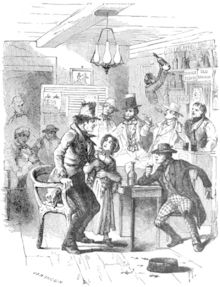Ten Nights in a Bar-Room and What I Saw There
| Author | Timothy Shay Arthur |
|---|---|
| Country | United States |
| Language | English |
| Genre | Temperance literature |
Publication date | 1854 |
Ten Nights in a Bar-room and What I Saw There is an 1854 novel written by American author Timothy Shay Arthur.
Plot

The novel is presented by an unnamed narrator who makes an annual visit to the fictional town of Cedarville. On his first visit, he stops at the new tavern, the Sickle and Sheaf. The proprietor, Simon Slade, is a former miller who gave up the trade for the more lucrative tavern. The business is a family affair, with Slade's unnamed wife, son Frank, and daughter Flora assisting him. The narrator also observes the town drunk, Joe Morgan. The father of a loving wife and family, he meets his moral downfall when introduced to alcohol. Morgan quickly becomes an alcoholic and spends most of his time at a bar. One day, his daughter begs him to return to his family. He initially ignores her desires until she is hit in the head by a flying glass as she goes to retrieve her father. Slade had initially thrown the tumbler at Morgan so, to a degree, her death is on his hands. On her deathbed, the daughter begs Morgan to abandon alcohol, to which he agrees. The novel progresses through the ruinous fall of more characters all at the hands of hard drink and other vices (gambling becomes another major reform notion in the text). Shay spends some time discussing corruption in politics with the corrupt "rum party" candidate from Cedarville, Judge Lyman. The narrator continually notes how even the drinkers in the story call for "the Maine Law" which will prohibit alcohol from being so temptingly available. The novel closes with the death of Simon Slade, already mutilated from an earlier riotous sequence of murders and mob mentality, at the hands of his son. The two had gotten into a drunken argument and Frank strikes his father in the head with a bottle. In the final scene the narrator sees the post with the once pristine and now gross and rotten Sickle and Sheaf totem chopped down after the town's moral fiber finally showed itself in a series of resolutions that led to the destruction of all the alcohol on the premises.
Analysis
In addition to its advocacy of temperance, the book is also significant because of its promotion of the Cult of Domesticity and prohibition. Arthur used the book to argue that women needed to steer men to the path of morality to protect the home. Nothing was as dangerous to morality as alcohol, so its use needed to be restricted by women.[1] The book is the first work to openly call for prohibition and was a popular temperance melodrama.[2][3]
Response
Ten Nights in a Bar-room was a financial success for Arthur and became the second most popular book of the Victorian Era, following Uncle Tom's Cabin.[4] The novel was easily transferred to play format, so it was frequently used to promote prohibition to large audiences. The play based on the novel continued to be popular even after the end of prohibition in the United States, although it was usually presented as a parody. [5]
Its first adaptation was for the Broadway stage by William W. Pratt in 1858 as Ten Nights in a Barroom. Among its film adaptations was a 1910 silent film starring Frank H. Crane and Marie Eline (now lost), a 1913 adaptation by Lee Beggs with a cast including Gladys Egan, a 1921 film directed by Oscar Apfel, and a 1931 film starring William Farnum as Joe Morgan and Tom Santschi as Simon Slade.[6]
References
| Wikisource has original text related to this article: |
- ↑ Martin, Scott (2005). Cultural Change and the Market Revolution in America, 1789-1860. Rowman & Littlefield. p. 219.
- ↑ Adams, Bluford (1997). E Pluribus Barnum: The Great Showman and the Making of U.S. Popular Culture. U of Minnesota Press. p. 125.
- ↑ "Ten Nights in a Bar Room". Roy Rosenzweig Center for History and New Media. Retrieved 23 May 2014.
- ↑ Chrzan, Janet (2013), Alcohol: Social Drinking in Cultural Context, Routledge, p. 76
- ↑ Walters, Ronald (1997). American Reformers, 1815-1860, Revised Edition. Macmillan. p. 134.
- ↑ Hischak, Thomas S (2012), American Literature on Stage and Screen: 525 Works and Their Adaptations, McFarland and Company, p. 239